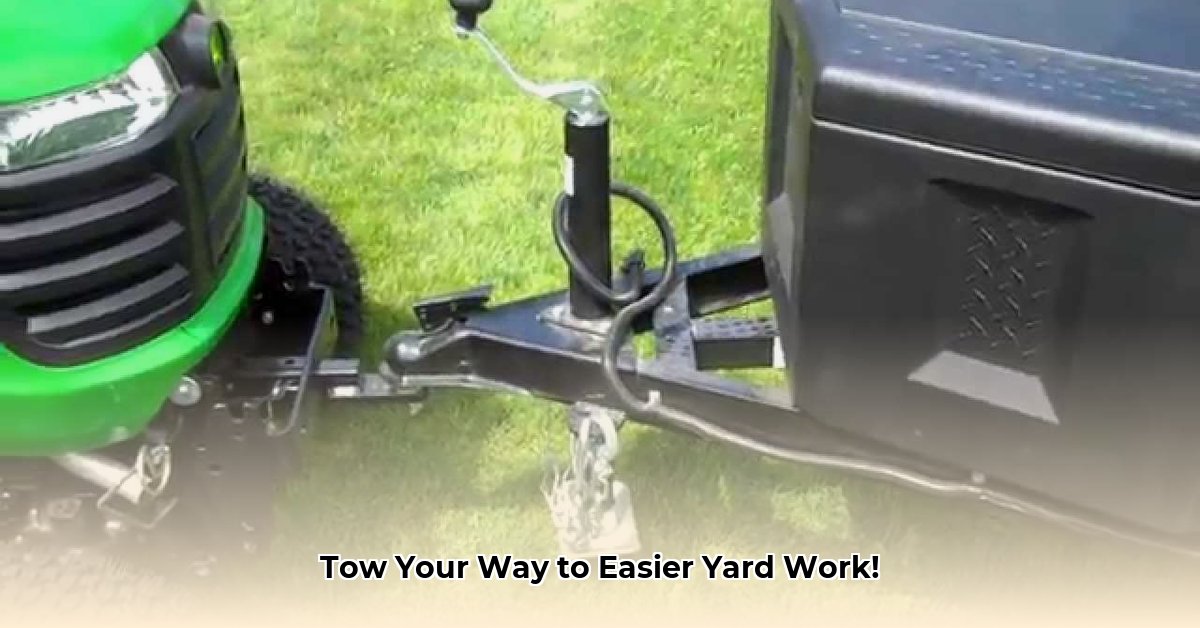
Understanding John Deere Lawn Tractor Tow Hitches
A John Deere lawn tractor tow hitch is a crucial attachment point allowing you to connect various implements, expanding your tractor's functionality beyond simple lawn mowing. This transforms your tractor into a versatile tool for various yard tasks, increasing efficiency and saving time. The right hitch is essential for maximizing your tractor's capabilities. For more on compatible trailers, see John Deere Trailers.
Choosing the Right Hitch
Selecting the appropriate John Deere lawn tractor tow hitch depends on several factors:
- Tractor Model: Compatibility is paramount. Always consult your owner's manual or the official John Deere website for precise model compatibility. The serial number is also vital.
- Intended Use: What tasks will you be performing? Hauling heavy materials requires a different hitch than spreading fertilizer. Consider the weight and type of attachments you intend to use.
- Weight Capacity: The hitch's weight capacity must exceed the combined weight of the implement and any towed load. Never exceed the specified limits.
Finding and Purchasing Your Hitch
Locating and purchasing a compatible hitch is relatively easy:
- Identify your tractor's model and serial number. This information is typically found on a sticker located on the tractor itself.
- Consult your owner's manual or the official John Deere website. These resources provide compatibility information and may offer recommended hitches.
- Shop online or at an authorized John Deere dealer. Online retailers offer convenience and price comparison, while dealers provide expert guidance and support.
Installing and Using Your John Deere Lawn Tractor Tow Hitch
Proper installation is crucial for safety and effective operation. Always follow the manufacturer's instructions meticulously. Rushing this step can lead to damage or injury.
Step-by-Step Installation (General Guidelines):
- Preparation: Gather necessary tools (specified in your owner's manual). Ensure the tractor is parked on a level surface, turned off, and the ignition is switched off.
- Alignment: Carefully align the hitch with the designated mounting points on your tractor.
- Attachment: Securely attach the hitch using the provided bolts and hardware. Tighten firmly, but avoid over-tightening.
- Inspection: After installation, inspect the connection for stability and ensure there is no wobble.
Important Considerations: Never exceed the hitch's weight capacity. Overloading can cause damage or injury.
Maintaining Your John Deere Lawn Tractor Tow Hitch
Regular maintenance prolongs the lifespan of your hitch and ensures safe operation.
- Regular Inspection: After each use, visually inspect the hitch for signs of damage (bent metal, loose bolts).
- Lubrication: Lightly lubricate moving parts to reduce friction and wear.
- Addressing Issues: Immediately address any damaged or loose components.
Expanding Your Yard Work Options with Attachments
A tow hitch unlocks a world of possibilities. Many attachments are compatible, dramatically increasing your tractor's versatility. Some common options include:
- Trailers: For hauling yard waste, landscaping materials, and tools.
- Spreaders: For distributing fertilizer, grass seed, or ice melt.
- Aerators: To improve soil aeration and lawn health.
- Snow Plows: For clearing snow from driveways and walkways.
Remember to always consult the individual attachment's instructions before use. Each attachment may have specific safety and operational guidelines.
Sustainability Considerations for Attachments
While this guide focuses on efficiency, sustainability is also important. While specific data on the environmental impact of John Deere lawn tractor tow hitches is not readily available, consider these broader sustainability factors:
- Material Durability: Choose durable, long-lasting materials to minimize waste from frequent replacements.
- Manufacturing Processes: Seek out manufacturers committed to environmentally responsible production methods.
- Repairability: Select attachments designed for easy repair rather than replacement, reducing waste.
- Weight and Fuel Efficiency: Lighter attachments improve fuel economy, reducing the tractor's carbon footprint.
Choosing sustainable attachments contributes to a more environmentally conscious approach to yard work and lawn care. Remember that sustainable practices extend beyond the attachment itself to encompass the entire operation. Fuel-efficient tractors and precision application techniques further contribute to minimizing environmental impact.